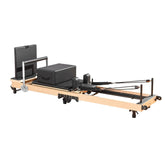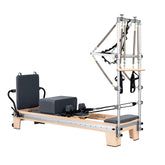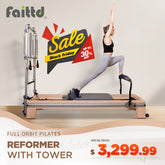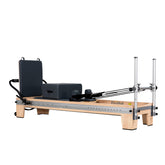Walking vs Reformer Pilates: Which One Works Better?
Wondering whether to lace up your walking shoes or book that Reformer Pilates class? Many people struggle to choose the right exercise that fits their lifestyle and delivers results. Walking offers a simple, accessible way to stay active with minimal equipment, while Reformer Pilates provides targeted strength training using specialized equipment. This article compares both exercises-examining their unique benefits, time requirements, and how they might complement each other in your fitness routine.
What Benefits Do Walking and Reformer Pilates Offer?
Walking and Reformer Pilates each offer unique health benefits. Walking is free, easy, and gives you good cardio exercise without special equipment. Reformer Pilates uses specialized machines to build strength and flexibility in targeted ways.
| Benefit | Walking | Reformer Pilates |
| Accessibility | Highly accessible, requires no equipment, suitable for all fitness levels | Requires specialized equipment and usually instruction, moderate learning curve |
| Cardiovascular Health | Excellent for heart health, improves circulation, lowers blood pressure | Moderate cardiovascular benefits, primarily during flow sequences |
| Strength Building | Primarily lower body strength, minimal upper body engagement | Comprehensive full-body strength, especially core, with balanced muscle development |
| Flexibility | Minimal flexibility improvements | Significant improvements in spine, hip, and shoulder mobility |
| Weight Management | Effective calorie burning with consistent practice | Moderate calorie burning, enhances metabolism through muscle building |
| Mental Health | Reduces stress, anxiety; releases endorphins | Improves mindfulness, body awareness, concentration |
| Injury Prevention | Strengthens bones and joints through weight-bearing activity | Corrects muscle imbalances, improves alignment and posture |
Reformer Pilates uses specialized Pilates machines like the Faittd Pilates Reformers to build strength and flexibility. Different types of home Pilates reformers provide flexible training options for various users. Home Pilates reformers now make professional-level training accessible to more people, offering versatile workout options for different fitness levels. Reformer Pilates is better than walking for core strength, posture improvement, and flexibility, while walking beats Pilates for heart health and ease of access. For mental health, walking in nature provides quick mood boosts, but Reformer Pilates creates stronger mind-body connections through focused movements.

Walking vs. Reformer Pilates: Time Investment Comparison
When planning your fitness routine, understanding the time investment for different exercises is crucial. Walking and Reformer Pilates have distinct time requirements that can influence which activity better fits your lifestyle. Walking offers flexibility with minimal preparation, while Reformer Pilates demands more structured time blocks but may deliver more targeted results. Knowing these differences helps you make realistic fitness plans based on your schedule constraints.
| Time Aspect | Walking | Reformer Pilates |
| Recommended Session Length | 30-60 minutes | 45-60 minutes |
| Weekly Frequency | 5+ days recommended | 2-3 sessions recommended |
| Setup/Preparation Time | Minimal (1-2 minutes) | Moderate (10-15 minutes) |
| Learning Curve | Almost none | Several sessions to master basics |
| Time to See Results | Longer for strength/flexibility changes | Faster for posture/core improvements |
| Ability to Multitask | High (can listen to podcasts, make calls) | Low (requires full concentration) |
| Travel Time | None if walking from home | Required for studio sessions |
Walking is better than Reformer Pilates for fitting exercise into busy schedules since it requires no special equipment or dedicated facilities and can be broken into multiple short sessions throughout the day. For efficiency of results per minute invested, Reformer Pilates outperforms walking by delivering more comprehensive strength, flexibility, and posture improvements in fewer weekly sessions. Both walking and Reformer Pilates offer valuable benefits, but your time constraints and fitness priorities will determine which exercise makes more sense for your lifestyle.

Goal Setting for Walking and Reformer Pilates
Setting effective goals is essential for success in any fitness journey, whether you're pursuing walking or Reformer Pilates. Both activities benefit from structured goal-setting approaches that help maintain motivation and track progress over time. The SMART framework (Specific, Measurable, Achievable, Relevant, Time-bound) provides an excellent foundation for establishing meaningful objectives for either walking or Reformer Pilates practice.
| Aspect | Walking Goals | Reformer Pilates Goals |
| Beginner Goals | Start with 10-15 minute walks, 3-4 times per week; gradually increase to 30 minutes daily | Begin with 1-2 sessions weekly focusing on proper form and basic movements |
| Progression Metrics | Track steps (5,000-10,000 daily), distance (miles/km), or time (minutes/day) | Progress through equipment resistance levels and exercise complexity |
| Strength Goals | Incorporate hills or intervals for increased intensity; add ankle weights for resistance | Target specific muscle groups with progressive spring resistance; master advanced exercises |
| Flexibility Goals | Combine with post-walk stretching routines; measure improved range of motion | Focus on elongation during exercises; improve spine mobility and joint flexibility |
| Posture Goals | Practice mindful walking with proper alignment; reduce forward head position | Achieve neutral spine alignment; strengthen postural muscles; reduce imbalances |
| Tracking Methods | Fitness trackers, apps, walking journals, or calendars | Progress photos, instructor feedback, exercise progression logs |
| Recommended Frequency | Daily walking (30+ minutes) or accumulated throughout day | 2-3 sessions weekly with rest days between for optimal results |
| Long-term Objectives | Building to 150+ minutes weekly of moderate activity; participating in walking events | Mastering advanced reformer exercises; improved body awareness and control |
Walking is easier to start and better for heart health and daily exercise, while Reformer Pilates builds core strength, improves posture, and targets specific muscles more effectively. Walking needs minimal equipment and no instruction, making it great for beginners, but Reformer Pilates delivers more precise body changes if you're willing to invest in professional classes.

How to Create a Routine That Works for You
Developing a sustainable fitness routine is essential for long-term success and enjoyment. Whether you're focusing on walking, Reformer Pilates, or a combination of both, creating a structured yet flexible schedule will help you maintain consistency while accommodating your lifestyle needs.
Build a Walking Routine
Creating an effective walking routine begins with understanding your current fitness level and gradually building from there:
- Start small: Begin with 10-15 minute walks and gradually increase duration by 5 minutes each week until reaching your target time (typically 30-60 minutes)
- Make it a routine: Walk daily at the same time to develop a habit-morning walking can boost metabolism and energy, while evening walking can reduce stress
- Use the 10-minute rule: On unmotivated days, vow to just do 10 minutes; when you begin, you'll likely continue longer than that
- Incorporate variety: Vary routes, terrain, and intensity to avoid tedium and work different muscle groups
- Track progress: Use a walking tracker, program, or simple journal to monitor fitness by monitoring for gains in distance, rate, or step count
- Build in recovery: Have one or two slow walking days a week to allow for body recovery
Incorporate Reformer Pilates into Your Schedule
Reformer Pilates requires more structured planning due to equipment needs and class availability:
- Frequency: For tangible results, attempt 2-3 Reformer classes per week with a last day of recovery between to allow for muscles to rebuild
- Session timing: Schedule 45-60 minute sessions, allowing for warm-up and cool-down time
- Progressive approach: Begin with fundamentals classes before advancing to intermediate and advanced sessions
- Consistency over intensity: More regular, moderate classes yield better long-term results than less frequent, high-intensity sessions
- Plan ahead: Book classes in advance to secure your spot and keep yourself on track
- Home practice: Between Reformer classes, practice mat Pilates exercises to maintain momentum and solidify principles
Balance Both Activities
Combining walking and Reformer Pilates creates a comprehensive fitness approach that addresses cardiovascular health, strength, flexibility, and posture:
- Complementary scheduling: Alternate 4-5 walking days and 2-3 Reformer Pilates days a week with sufficient recovery time
- Activity pairing: Alternate days with both activities by walking in the morning and performing Pilates at night, or vice versa, based on your energy cycles
- Priority alignment: Schedule your week based on your top priorities-extra walking for cardiovascular focus, extra Pilates for flexibility and strength
- Listen to your body: Adjust intensity and duration based on how you feel, incorporating active recovery days as needed
- Seasonal adjustments: Gradually increase indoor Reformer classes during poor weather and outdoor walking in better seasons
- Progress tracking: Keep a total activity journal to find patterns and measure balanced progress
A thoughtfully integrated routine might include daily walking (varying between shorter and longer distances) with Reformer Pilates sessions on Mondays, Wednesdays, and Fridays, leaving weekends for longer recreational walks or complete rest.
Walking and Pilates for a Stronger, Healthier You
Getting fit with walking and Reformer Pilates is simple-just show up regularly. Create a schedule that fits your life and stick with it. You'll get stronger, more flexible, and healthier over time. Every walk and every Pilates class makes a difference, no matter how small. Don't put it off until tomorrow-start today by taking a walk around the block or signing up for your first Pilates class. Your future self will be grateful you began now.

Frequently Asked Questions About Walking and Reformer Pilates
Q1: How much equipment do I need to start walking as exercise?
Walking requires minimal equipment-only supportive, comfortable shoes, moisture-wicking clothes appropriate for the weather, and maybe a water bottle. For a progress tracker, all you need is a smartphone with a no-cost step-counting app, although spending money on a separate fitness tracker or smartwatch yields more comprehensive results if you find yourself later on deciding.
Q2: Can I do Reformer Pilates if I have back problems?
Yes, most individuals with back issues will find Reformer Pilates very helpful since it is low-impact and strong on core strengthening. It is, however, important to report your condition specifically to your teacher prior to initiation. They are able to accommodate your needs with modified exercises as well as ensure correct posture to avoid the exacerbation of current conditions. Some studios actually have special back care classes available.
Q3: How quickly will I see results from combining walking and Reformer Pilates?
Most people notice increased energy and mood within 1-2 weeks of consistent practice. Physical changes typically become apparent after 4-6 weeks, including better posture and increased stamina. More significant changes in strength, flexibility, and body composition typically occur after 2-3 months of consistent exercise.
Q4: Is walking or Reformer Pilates better for weight loss?
Neither is superior alone-each functions differently. Walking burns calories more intensely during the exercise itself, and so it is effective at creating a deficit of calories. Reformer Pilates builds lean muscle, boosting your metabolic rate throughout the day. Achieving maximum weight control, along with correct dieting typically leads to the best results.
Q5: Can seniors safely practice walking and Reformer Pilates?
Yes. Both exercises are readily adaptable to seniors. Walking is merely adjustable in intensity and length, and Reformer Pilates features controlled resistance that's gentle on joints. Seniors can start with led Reformer sessions to perfect form and may even appreciate specialty senior classes focused on balance, bone density, and functional movement patterns.
Q6: What should I do if I miss several days of my routine?
Simply restart without remorse or trying to "catch up" on lost sessions. Begin with a lower intensity-a briefer walk or a more basic Reformer class-then gradually return to your previous level over the course of a week. Long-term consistency is better than perfect compliance, and forcing too much exercise after a hiatus increases the risk of injury.





